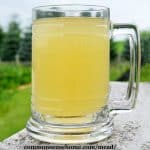Mead – 5 Things You Need to Know (And a Recipe)
Mead may be the world’s oldest alcoholic beverage. Many modern versions are just for enjoyment, but we’ll show you why (and how) to brew old school (naturally fermented) mead.
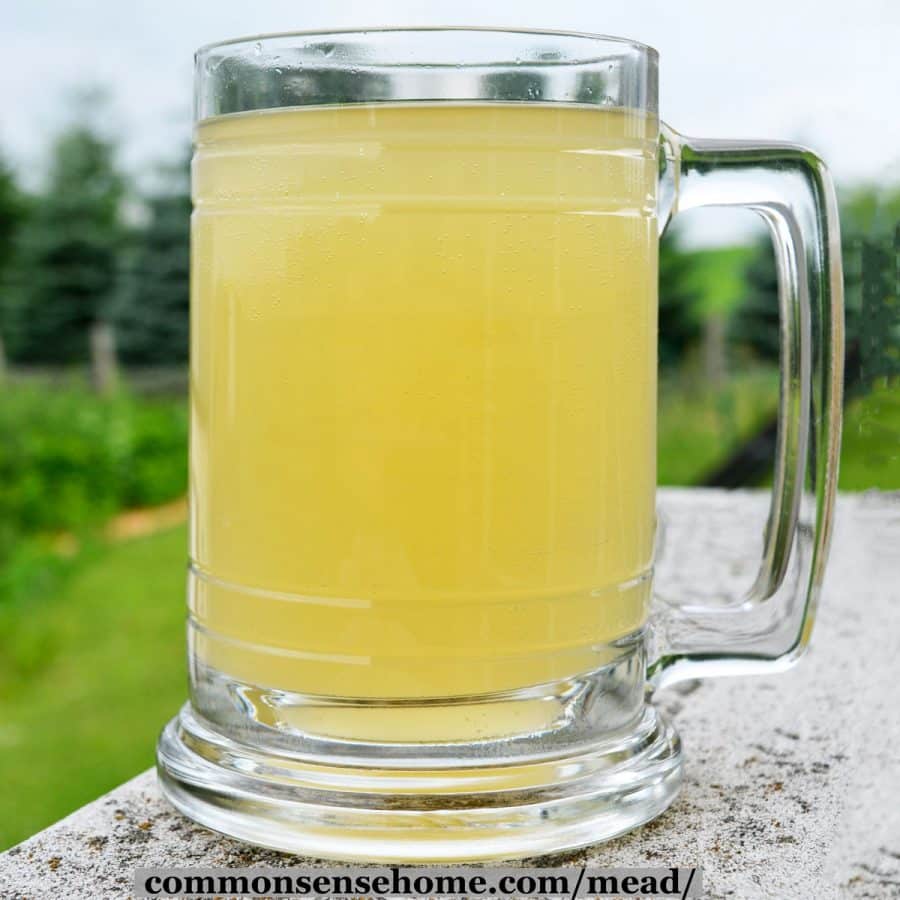
Why naturally fermented? Beyond the unique flavor possibilities of wild ferments, they also have probiotic and potential medicinal qualities. In a world where antibiotic resistant bacteria are becoming a growing problem, our old ally and “drink of the gods” may come to our rescue again.
Read on…
What is mead?
Mead is an alcoholic beverage where the majority of the sugar for the alcoholic ferment comes from honey. Alcohol content varies from around 4% to over 20% alcohol by volume, depending on the type of yeast, ingredients and aging.
Although sometimes called honey wine, mead is a separate class of beverage. Some companies sell white grape wine with added honey and call it “honey wine”, so make sure you check the label.
It’s believed the first honey ferments were likely accidental, resulting from wild yeast fermented honey water. The drink was enjoyed by the Norse, Ancient Greek, Africans and Chinese.
Norse legends about the origin of the drink involve Odin, dwarves, and a war between the gods. Archaeological finds in China contained residue a mixed beverage of rice, honey and fruit dated back to 9,000 years ago.
Mead Can Taste Like Beer or Wine or an Entirely Different Beverage
Most commercial meads taste more like wine – with a kick. There are sweet and dry options,and recipes with added fruit or herbs. If you find you don’t care for your first taste, try another type.
Once you get into home fermentation, there’s a lot more variation. If you drink your brew young, it tastes more like beer or sparkling cider. It also has a lower alcohol content, making the mug an acceptable serving vessel, versus a wine glass for older brews.
Which brings us to…
How soon can you drink it?
A basic small mead can be ready to drink in ten to fourteen days. Aged brews are ready in six months to a year, or longer.
What are the different types of mead?
There are many different varieties of mead, including sweet, semi-sweet and dry meads. Those fermented with fruit are called melomels. A honey/apple juice ferment is called cyser. Metheglins have spices added.
Honey ferments also include honey beers, grog, T’ej and ale.
It’s Legal to Brew at Home
Although you can’t sell your brew, it’s legal to brew and consume mead in most areas. (This also applies to beers and homemade wines.) Distilled spirits commonly require special permits and/or licenses.
Is mead good for your health?
Long term readers may remember the article “Honey as Medicine”, in which we discussed the use of honey for healing wounds and preventing infection. When fermented, it creates a potent probiotic beverage.
A 2006 study of tej (Ethopia honey wine) found large numbers of Saccharomyces cerevisiae yeasts, which have a probiotic effect, make nutrients easier to absorb, provide folate, and protect from mycotoxins.
See “Beneficial Effects of Probiotic and Food Borne Yeasts on Human Health“. The study also found high amounts of Lactobacillus species bacteria, which have been shown to reduce the severity and duration of illness.
Scientists in Sweden launched a mead called Honey Hunter’s Elixir. In the article “Honey-based mead may curb antibiotic resistance, say makers”, one of the scientists notes:
“Well, we’ve seen in our research that the honey bees actually add great flora of lactic acid bacteria in honey so the mead, when produced, is actually fermented by these lactic acid bacteria together with wild yeasts and the lactic acid bacteria can really kill off all the dangerous pathogens that are even resistant against antibiotics.
So our thinking is that the mead, these (antibacterial substances in) lactic acid bacteria in the drink can actually be transferred to your blood and help you when you are infected with dangerous bacteria or promote health, preventing infections,”
Would you like to save this?
If you combine healing herbs with the probiotic benefits of honey, it’s a one-two punch.
Note – the probiotic health benefits of mead only apply to brews are not pasteurized or chemically treated to kill off microbes. Natural ferments appear to add extra benefits compared to commercial yeast strains.
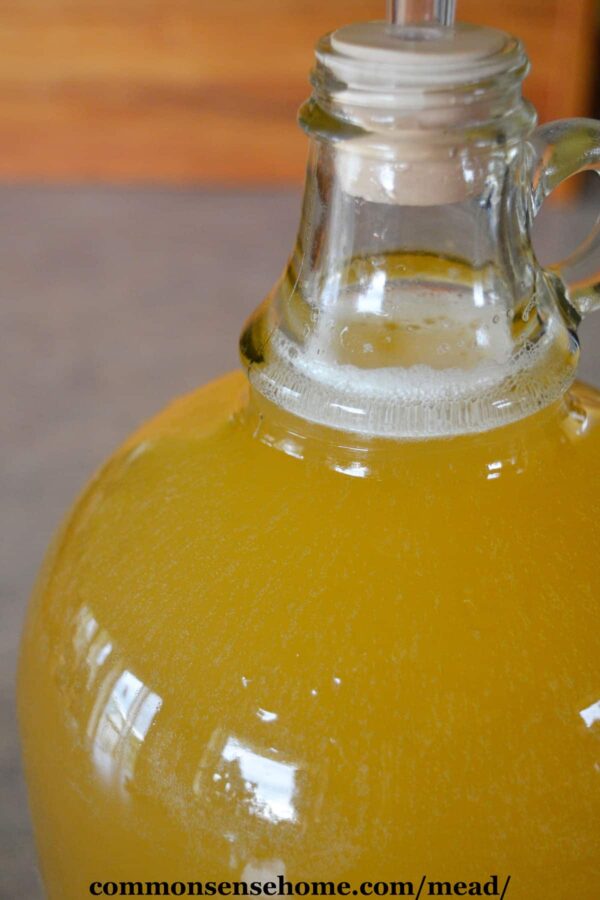
Basic Semi-Sweet Mead Recipe
This traditional mead recipe is adapted from “Make Mead Like a Viking: Traditional Techniques for Brewing Natural, Wild-Fermented, Honey-Based Wines and Beers“.
The author, Jereme Zimmerman, describes himself as a “writer and traditional brewing revivalist”. He gives presentations around Pacific Northwest.
Equipment needed:
- 2-3 gallon wide-mouthed ceramic, glass or food-grade plastic fermentation vessel. (Don’t use metal, as honey is mildly acidic.)
- Wooden spoon
- Heavy duty cheesecloth or flour sack to cover the ferment
If you wish to age your brew, you’ll need:
- 1 gallon carboy with airlock
- Siphoning tube
- Wine bottles (and corker) or bail-top bottles
Brewing Tips
Clean all equipment thoroughly, and practice food sanitation practices. You can use products made for cleaning brewing supplies, but hot, soapy water and a clean rinse will get the job done.
Don’t overheat your water or honey! If you boil or pasteurize ingredients, you kill off the wild yeasts. Gently warming honey to help it dissolve is fine. Think “no warmer than bath water”.
To give mead body, it needs nutrients (sugars), tannin and acid. Citrus fruit is a good source of acid. The raisins in this recipe add nutrients, tannin and wild yeasts. Oak leaves or grape leaves also add tannin.
As you learn, you can experiment with other ingredients – or buy a good guide book – or both. Endless flavor variations are possible with flowers, herb, fruits, vegetables and spices. You can even make mushroom mead!
Keep your fermentation vessel tightly covered when you are not stirring, especially if fruit flies and ants are around. They love sweet ferments. I have old headbands that I use to hold down my flour sack towel, but any strap or tie will do. (Read here for more on ant and fruit fly control.)
If you want carbonated mead, use heavy duty champagne bottles or swing-top bottles. They are designed to handle pressure build up. Regular wine bottles are fine if fermentation is finished before bottling. (See Notes in recipe below.)
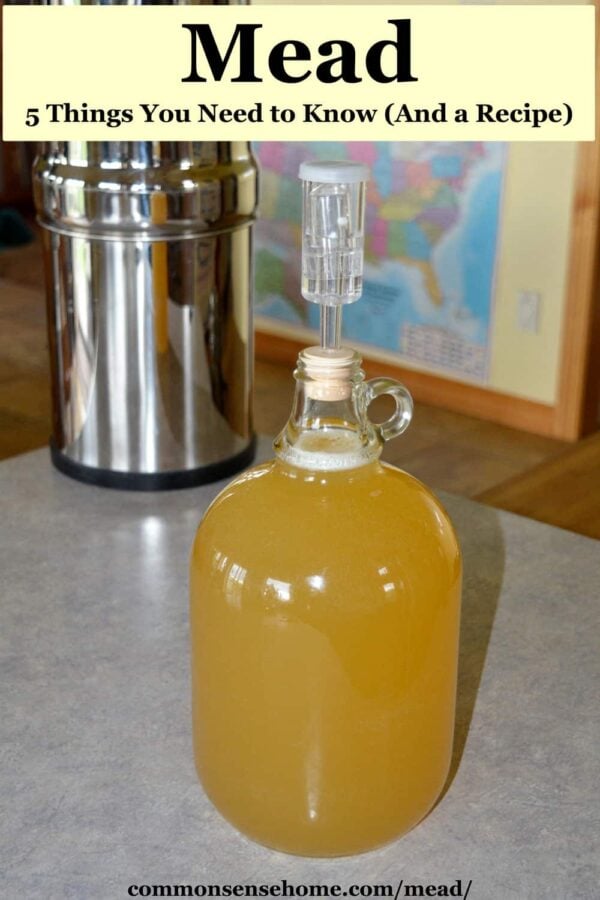
Basic Semi-Sweet Mead
A lightly sweet, naturally fermented mead, perfect for the beginning home brewer.
Ingredients
- 2–3 pounds (about one quart or .9 to 1.3 kg) raw, unfiltered local honey
- 1 gallon (3.8 liters) of clean, non-chlorinated water
- 8–10 raisins
- A couple of squeezes of a lemon or orange
Instructions
- Mix water and honey in your wide-mouthed fermenting vessel. Stir until dissolved.
- Stir in raisins and citrus juice.
- Cover your fermenting vessel and set it in a warm (60-80F, 15-27C) location, out of direct sunlight.
- Stir the brew vigorously for a few minutes, several times per day.
- Within three to five days, you should see signs of fermentation. The mead will be bubbly and fizz slightly after stirring.
- Continue regular stirring for a couple more days, then strain and transfer the brew into a carboy with airlock.
- Drink the mead in a week or two if you like it young and sweet with less alcohol (5-6%).
- For a stronger mead (10-12%), rack the mead after a month, and then one or two more times over the next six months. Consume at six months, or bottle and age the mead for a year or more.
- To age, place bottles on their side in a cool location, such as a cellar.
Notes
To test mead to see if it’s safe to bottle, add a half teaspoon of sugar or a bit of honey and swirl the carboy. If it causes a strong reaction, the mead is not ready to bottle. Meads bottled a bit young in a thick bottle will be carbonated, but if not done with care, you risk popped corks or bottle bombs.
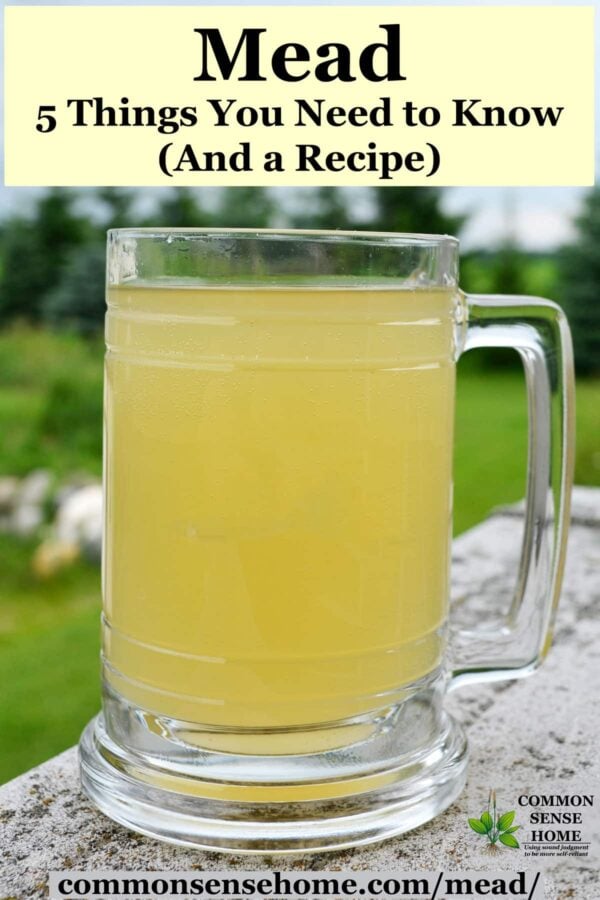
January 2021 note: We sampled the mead at six weeks (photo in mug above), 6 months, and 18 months. It was excellent all three times.
At first, it’s sweet and bubbly, more like a wine cooler. At 6 months, it was less sweet, but still lightly effervescent. By 18 months, it was drier, but still had just a hint of bubbles. Lovely stuff!
More Information on Natural Fermentation
We have a wide range of recipes and book reviews on the site, including:
- Wild Yeast Brewing – Books About Wild Beer, Wine, Mead and More – this post has great references for medicinal brews and making a starter with wild yeast to help ensure a successful ferment.
- Brew Beer Like a Yeti – Techniques and Traditional Recipes – also by Jereme Zimmerman
- How to Make Kombucha – the ever so slightly alcoholic drink that’s been gaining popularity in healthy lifestyle circles.
For a demonstration of bottling your honey wine, you can watch the video below. We bottled pear wine, but the technique is the same.
Or watch on youtube.

